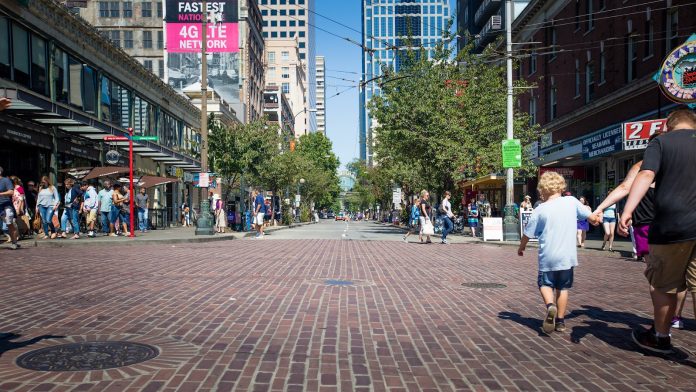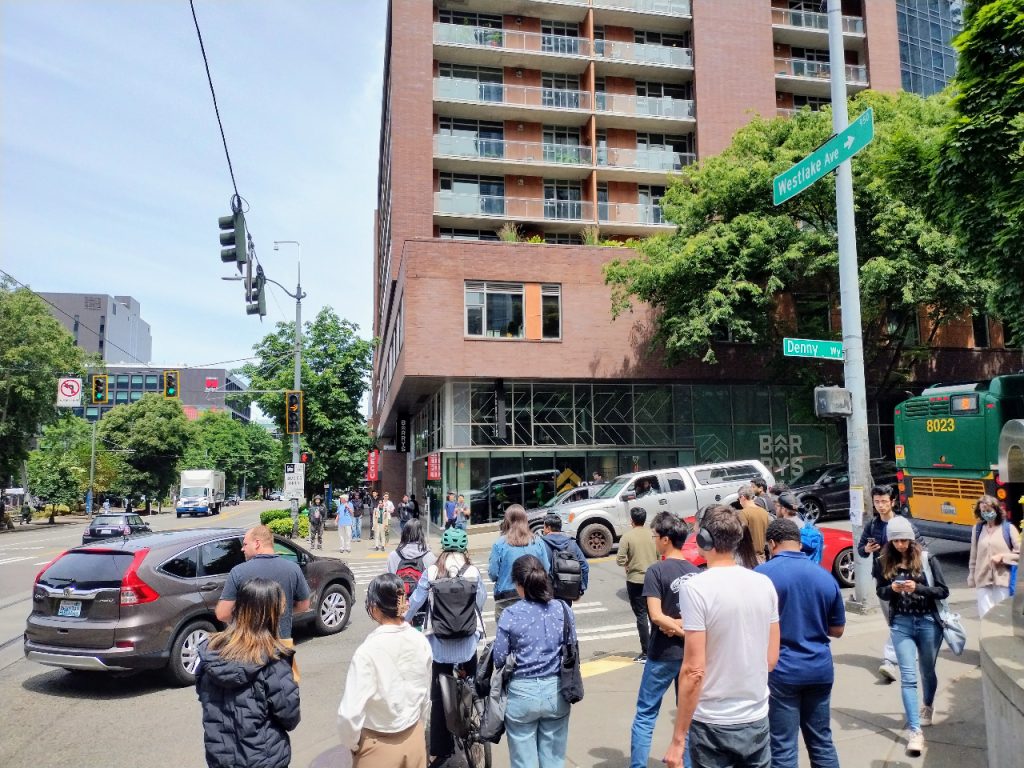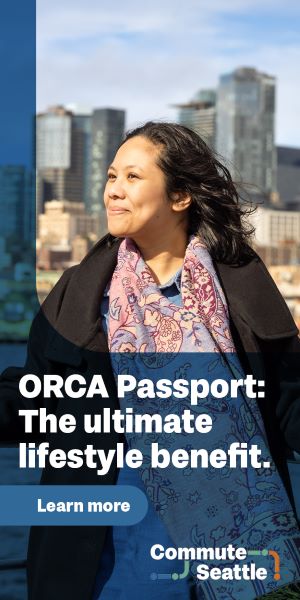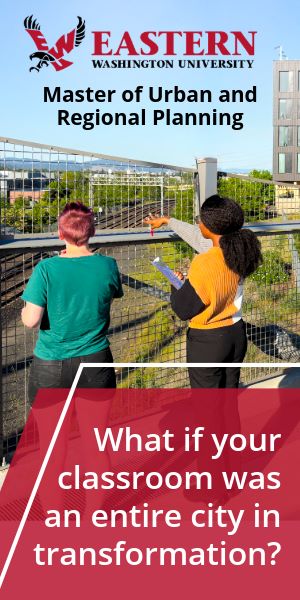
Many cities are designed in a car-centric, sprawling way, rather than at people-friendly scales. The 15-minute city is an urban planning concept that intends to change this, with the idea that people should be able to access daily services and essentials within a 15-minute walk or bike ride.
It sounds simple enough, but it has not been without controversy, and the implementation of the concept comes with additional challenges. For example, all planning concepts require political buy-in and funding is necessary for changes to actually take place. In addition, even when changes are made, they don’t necessarily serve all populations equally or in a culturally-specific manner. Furthermore, infrastructure and neighborhood improvements can contribute to displacement of low-income communities and gentrification.
Nonetheless, improving walkability, traffic safety, access to services, and ensuring that people have viable options to get around other than cars, are all important and beneficial urban planning goals. This article will first discuss how the 15-Minute City concept is defined. Then, it will cover the communication of the concept and pushback against it. Finally, it will go through the metrics of the concept, the implementation, and the effects, followed by a couple of real-life examples both in Seattle and elsewhere.
What is a 15-Minute City?

The roots of the 15-minute city concept go back a long way, and can be found in planning approaches such as New Urbanism, Jane Jacobs’ models of neighborhood planning, transit-oriented development, and others. All of these focus on proximity of services as a key element of high-quality urban space.
“There’s nothing new about the concept,” Emily Talen, professor of Urbanism at the University of Chicago, said. “I’m glad it’s taken off like it has, but this is completely central to what urban planning is about, which is putting people in proximity to the goods and services that they need. It’s just that simple.”
Dick Ettema, professor of Urban Accessibility and Social Inclusion at Utrecht University concurred. “We have seen various elements of this 15-minute city idea already before. We have had Compact Cities in the Netherlands. We have had New Urbanism. We have walkable cities, livable streets, and complete streets,” Ettema said. “It’s an appealing story. It’s also a simplified story.”
Carlos Moreno, a Franco-Columbian urban planner and Sorbonne professor, pioneered the 15-minute city term, which was quickly adopted by and popularized by Paris Mayor Anne Hidalgo. Some of the key components include walkability, mixed-use buildings, bike lanes, public transport, and services such as supermarkets, doctors, schools, and parks. These should all be reachable within 15 minutes by foot or by bike. Other related concepts use different time frames or metrics to refer to a similar outcome, such as the “20-minute city”, the “20-minute neighborhood,” or the “one-mile city.”
The intention is to improve the quality of life of residents, reduce carbon emissions, focus economic growth locally, increase active travel and health outcomes, and build strong communities.
Like some other urban developments such as bike lanes, bus lanes, or affordable housing, the 15-minute city concept has also faced pushback from conservatives, as well as conspiracy theories in both the UK and the US, particularly in response to the idea of reducing car dependency. This response is relatively unique, as most urban planning concepts do not draw such a large public reaction. The reasons behind this reaction seem to be multiple.
Devin Silvernail, former policy director for Seattle Councilmember Tammy Morales, helped promote 15-minute city style interventions in Seattle.
“There was a misunderstanding that came particularly from one town in the UK,” Silvernail said, in which the 15-minute city concept was communicated poorly.“That [misunderstanding] spread, where people were saying, ‘You can’t drive through this neighborhood or you can’t park here, you can’t do this and you can’t do that.’ That’s what people heard, that some liberty they have, their movement, was being taken away. I think it really boils down to communication.”
Professor Ettema also agrees that the communication of the idea may have played a role: “If it’s about selling [an idea to the public], selling is often about simplifying. And while it makes it appealing for some, it may make it also more threatening to others.”
Accessibility vs Walkability: 15 Minutes for Whom?
The 15-minute city is an intervention that is intended to increase walkability. However, a distinguishing point that is critical to note is that walkability is not the same as accessibility.
As Anna Zivarts, Director of Disability Mobility Initiative at Disability Rights Washington, said: “A lot of places that people might consider walkable aren’t aren’t smooth, or they involve a lot of steps and so for folks who are using wheelchairs or walkers or canes like that can be really challenging.”
Numerous walkable cities in Europe such as Amsterdam or Marseilles rate highly for walkability. However, these cities have numerous streets covered in cobblestones, with narrow footpaths. In the case of Amsterdam there is a high level of bicycle traffic, and in Marseilles there are many steps.
These places may meet a 15-minute metric of “access to services,” but are not at all accessible for people with mobility devices such as wheelchairs or canes, as well as parents with prams or elderly people.
“[The 15-minute idea] sort of assumes that the distance someone could travel in 15 minutes is equal. But I don’t think people, who are not disabled, realize how much longer it can take someone who’s disabled to navigate a distance,” Zivarts said. “For some people, 15 minutes could be more like 45 minutes.”
Without addressing concerns about accessibility and disability rights, cities that otherwise achieve the 15-minute ideal will have a big asterisk. To overcome this pitfall, cities should integrate accessibility into the 15-minute city concept, ensuring that pathways and transit are accessible for all, in addition to being high quality.
Barriers: Idea vs Implementation
In cases where urban areas might benefit from the 15-minute city concept, there are still a number of barriers. For example, in the US, Silvernail noted that there are big cultural barriers that prevent people from even necessarily wanting or considering the idea of the 15-minute city. “There is this very ingrained idea in the United States to say, well, you know, we’re not Barcelona, we’re not Tokyo, we’re not Buenos Aires, and therefore it can’t happen here,” Silvernail said.
In addition, even if residents might want this idea, it always has to go through political hurdles, and the decision-makers are usually not at the neighborhood level that is primarily affected. City-wide or nation-wide decisions are made, governance levels at which the 15-minute city may not always be a primary concern. While individual initiatives or neighborhoods might be very keen, they don’t always have funding or any political power to make it happen.
“Unfortunately right now a lot of the ways that improvements get funded is through grants,: Zivarts said. “So communities have to go and apply to the state, or even the federal government for these grants. But you have to have a competitive application, and so you have to have people on staff who know how to write grant applications. And there are the communities that have the resources to do that and other communities that don’t.”
Wider implementation of 15-minute cities may also require easing zoning restrictions and other regulations, such as parking mandates, that slow down urban transformation.
“We really need to change the rules of city building in the US.” Talen said. “There are small-scale developers who want to get in there and change the city, and they are getting blocked by zoning rules.”
The Effects: Better Health, Quality of Life… and Gentrification?
Assuming that the 15-minute city actually gets implemented, having services in closer proximity and active multimodal travel options brings a number of benefits to the urban population. C40 Cities notes that the “physical and mental health benefits of active travel, cleaner air, easy access to healthy food options, quality green space, and stronger community ties that reduce loneliness are vast and well documented.”
Unfortunately, the side effect of these improvements can be, in some cases, gentrification. However, it can be hard to know the direction of “causality” in such cases, Ettema said. For example, the area may already be gentrifying, and therefore provided with infrastructure improvements and investments. Or, these investments may actually cause the gentrification process.
Devin Silvernail pointed to anti-displacement approaches that can help, such as ensuring that a large proportion of any new development or increased density includes social housing, and that additional services are appropriate for the existing population.
“We need to ensure that we’re not putting in a Whole Foods [in working class neighborhoods],” Silvernail said. “Instead, we’re putting in something that is affordable to the people who live here.”
Ettema said that avoiding the narrow concentration of investments in infrastructure and amenities in one neighborhood (especially those vulnerable to displacement) but instead spreading them citywide, can potentially buffer displacement pressure.
Now let’s take a look at a few examples.
Seattle’s Plans and Potential

Adoption of the 15-minute city concept in Seattle has long been in discussion, but as of yet it appears that there is no concrete plan to adopt the approach. Instead, Seattle’s Comprehensive Plan 2015-2035 continues to focus on the “urban village” approach of planning, a concept that was adopted in Seattle in the 1990s.
However, a 2021 moveBuddha study found that Seattle was somewhat of a 15-minute city already (it ranked #12 out of 25 cities studied). This was based on walking and biking scores, combined with other scores such as density of childcare, restaurants, and community services, as well as the affordability of housing.
Another study by Nat Henry also showed that Seattle has some areas with high walkability and good access to parks, bus stops, restaurants and coffee shops. However, this map also showed that “only 44% of Seattleites can walk to basic city amenities,” and that “27 neighborhoods—including large portions of West Seattle, Delridge, and Northeast Seattle—are extremely unwalkable, with less than 10% of their residents able to walk to basic amenities.”
“Politically right now, Seattle is very skeptical about new things and bigger ideas,” Silvernail said. “There are bureaucratic barriers in place that are making it kind of difficult.”
The challenge remains that transforming a potential 15-minute city into an intentional plan, with continual and specific steps in that direction, takes real political approval, financial resourcing, and planning.
Paris, the Poster Child

Paris Mayor Anne Hidalgo made headlines for her adoption of the 15-minute city approach. Some of her decisions and plans, such as pedestrianizing the Voie Georges-Pompidou, a large highway along the banks of the Seine, faced some pushback and controversy. Nonetheless, the rollout of bike lanes and walkable spaces under Hidalgo’s direction in Paris has been (so far), relatively effective.
The French newspaper Le Monde reports that between October 2022 and October 2023, bicycle traffic monitored by sensors in Paris doubled. In addition, during rush hour, bicycles now outnumber cars.
A study by the Paris Urbanism Agency (Apur) also found that walking increased by 50% between 2001 and 2018, that public transport overtook cars as the second-most popular means of transport (walking is in first place), and that “the rate of motorized households lowered generally: -17% in Paris, -5% in metropolitan municipalities outside Paris and a total of -7% for the Metropolis as a whole.”
Many of these changes have been attributed to Hidalgo’s policies, showing a crucial shift in the urban experience in Paris. Nonetheless, a recent study from 2024 shows that the transformation in Paris is not yet complete, finding a “highly accessible city center (though with some internal differences in terms of types of amenities)” contrasted with “a less well-equipped periphery, where lower-income neighborhoods are more often found.” Even in the poster child for 15-minute cities, there is still a lot of work to be done.
Melbourne’s 20-Minute Neighborhoods

Another example of a city that is attempting to enact this concept under a slightly different moniker is Melbourne and its 20-minute neighborhoods. This initiative is being undertaken at the state level, with the Australian state of Victoria guiding the transformation of the city through the Plan Melbourne 2017–2050 strategy.
This includes safe, accessible and well-connected neighborhoods for pedestrians and cyclists, local services and destinations, high quality public spaces, and higher-density housing, among other things. On a positive note, the plan specifies what the 20 minute metric actually entails, stating that a “20-minute journey represents an 800 meter walk from home to a destination and back again or a 10-minute walk to your destination and 10 minutes back home.”
The pilot programs and experiments with community partnerships have also informed the program further about how best to make and expand infrastructure improvements. Like other cities, interventions in Melbourne have applied more commonly in the inner city, while outer neighborhoods still require more investment.
The Roadmap is Clear
The 15-minute city idea is a new name for an old concept, but one that nonetheless does lead to improved health, quality of life, stronger communities, local economy improvements, and emissions reductions. There are also a number of challenges in the implementation of a 15-minute city, as well as unintended side effects, in some cases.
Nonetheless, the benefits of 15-minute cities far outweigh the potential negative outcomes, particularly if development is done through an integrated and well-communicated process, that engages community and meets local needs. Cities like Melbourne and Paris are already showing the way.
Leah Hudson is an editor and writer published by Insider, Atlas Obscura, and Penguin Random House New Zealand. Leah loves to write about sustainable urban development, mental health, and matters of the heart. She spends her time reading, walking her dog, and eating unreasonable amounts of chocolate. You can find her at https://leahhudsonleva.com/.




